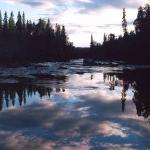Sights Karelia, Russia
 Karelia is exceptionally rich cultural and historical and natural sites that will satisfy the varied interests of tourists. The number of such facilities totaling about 4 thousand. Among this variety are the following:
Karelia is exceptionally rich cultural and historical and natural sites that will satisfy the varied interests of tourists. The number of such facilities totaling about 4 thousand. Among this variety are the following:State Historical-Architectural and Ethnographic Museum-Reserve "Kizhi". Located on the eponymous island in Lake Onega, 65 km from Petrozavodsk. The architectural complex of the museum-reserve includes 70 national monuments of wooden architecture of the XV-XX centuries., Whose core is the ensemble of the Kizhi churchyard, which consists of Church of the Transfiguration (1714), Protection Church (1764) and bell (1874). In 1990 the Kizhi churchyard monuments and architectural environment of the decision of the general session of UNESCO included in the UNESCO list of World Cultural and Natural Heritage.
Balaam - a picturesque archipelago of 50 small islands in the northern part of Lake Ladoga and placed them on an ancient monastery. Balaam also famous for its diverse cultural natural objects: gardens, groves, alleys, representing a remarkable creation of human hands.
The Kivach - the second largest, after the Rhine, plain waterfall in Europe. Drop height of water is 10,7 m. It is situated on the Suna River in the central part of Karelia. The most famous waterfall in Karelia. In the light hand of GR Derzhavina - the first Olonets governor and an outstanding poet, who dedicated his 1791 ode to the famous "Waterfall", Kivach occupied a prominent place in the work of many poets, artists, writers.
Petroglyphs on the eastern shore of Lake Onega. On outstanding sloping into the lake and smooth granite rocks - capes opened about 800 different designs.
Assumption Church (1774) in the town of Kondopoga strikingly high (42 m), the graphic clarity of outline, originality of the volume, spatial composition. It is considered the most advanced among her modern and more ancient Russian tent structures. It stands on a promontory, outstanding in Lake Onega.
Martian water. Russia's first resort "Marcial Waters", established by order of Russia's first emperor Peter the Great. Located 50 km from Petrozavodsk in the picturesque countryside. Therapeutic factors: mineral nitrogen glandular gidrokarbonatnosulfatnye water (4 wells) and high-quality curative mud. The range of indications for treatment is very wide. In the picturesque valley between two high ridges is a church built in 1721 for the holiday resort. It stores turned candlesticks made by the hands of Peter I, the original iconostasis, full of allegories glorifying the victory of Russian arms in the Northern War (painting of the first quarter. XVIII), carved wooden sculptures and other elements of the church, preserved from the time of Peter. Near the sources of healing Martian water in the home office of the Mountain (1830) is a small museum. Presented there things from the royal palaces of the resort, products Olonets Peter's factories during the war with Sweden, and more colorfully complement the guide on the life story of Russia's first health resort, its oblivion after the death of Peter the Great and the revival in the XX century.
Significantly, and other attractions of the Republic: Petroglyphs of the White Sea, Seyda Islands Body in the White Sea, White Sea Karelia Runopevcheskie village, the Assumption Cathedral in the town of Kemi, the National Park Paanajärvi, Vodlozersky National Park, a monument of architecture of Lake Ladoga.
The image of Karelia is particularly associated with the edge of the blue lakes. Indeed, the lakes are extraordinarily high - over 61 thousand. By their number per 1 sq. km area, Karelia confidently takes the first place not only in Russia but also among regions of the world. Karelian lakes are very different in size - from small "lambushek, drainage and nameless, to the largest in Europe - Ladoga and Onega. Dominate the lake with an area of the mirror up to 1 sq km, but many larger, up to more than 10 square kilometers, and 20 of them in excess of 100 square kilometers Overall lake in Karelia is 11,4%, which is noticeably higher than that of its neighbor Finland, and almost 2 times - than in the Murmansk region. Many of the lake to its origin is crustal fault movements, but the majority - is eroded and the accumulating effects of glaciers. The first - the deeper, usually have an elongated shape, high rocky, often steep, the banks and little islands. Configuration glacial lakes is much more diverse - they are distinguished by an abundance of islands, bays, straits and the relatively small depth. However, very often the lake are of mixed origin, and it makes them look extra flavor. The deepest lake is Lake Ladoga Karelia: its maximum depth is 260 m. noticeably smaller Onega - 126 meters, and large lakes such as Syamozero - 97 pm, Topozero - 56 m. It is in the company of lakes - the giant "wormed" tiny, in comparison with them, typically tectonic lake Paanajärvi, stretched a narrow strip (width 1,5 km., length 24 km) among the hills of north-western Karelia. Its depth - 131 m. This - Karelian mini - Baikal.